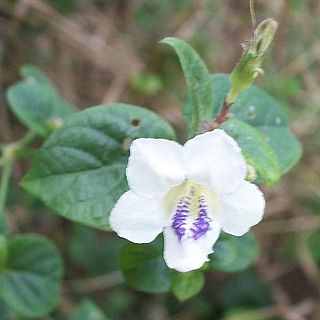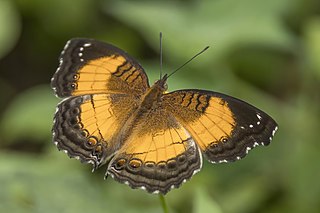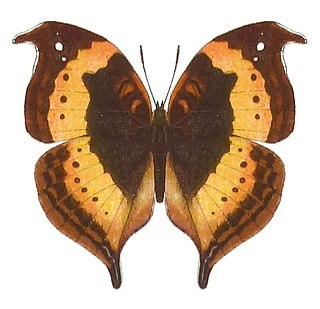
Asystasia gangetica is a species of plant in the family Acanthaceae. It is commonly known as the Chinese violet, coromandel or creeping foxglove. In South Africa this plant may simply be called asystasia.

Junonia is a genus of nymphalid butterflies, described by Jacob Hübner in 1819. They are commonly known as buckeyes, pansies or commodores. This genus flies on every continent except Antarctica and Europe. The genus contains roughly 30 to 35 species.

Junonia oenone, the blue pansy or dark blue pansy, is a Nymphalid butterfly native to Africa. "Blue pansy" is also used in India to describe Junonia orithya.

Trida barberae, or Barber's ranger, is a species of butterfly in the family Hesperiidae. It is found in southern Africa, from the Cape Province to Zimbabwe, Lesotho, Transvaal, the Free State and KwaZulu-Natal.

Paralethe is a monotypic butterfly genus in the family Nymphalidae. Its one species Paralethe dendrophilus, the bush beauty or forest pride is found in South Africa.
Apallaga mokeezi, also known as the large sprite, large flat or Christmas forester, is a species of butterfly in the family Hesperiidae. It is found in South Africa and Mozambique. The habitat consists coastal forests and montane forests.

Metisella metis, the gold spotted sylph, is a butterfly of the family Hesperiidae. It is found in the Cape and KwaZulu-Natal in South Africa.

Acraea natalica, the Natal acraea, is a butterfly of the family Nymphalidae, which is native to East and southern Africa.

Durbania amakosa, the Amakosa rocksitter, is a butterfly of the family Lycaenidae. It is found in South Africa.

Iolaus diametra, the natal yellow-banded sapphire, is a butterfly of the family Lycaenidae. It is found in Africa, roughly from South Africa to Ethiopia.

Cigaritis natalensis, the Natal bar or Natal barred blue, is a butterfly of the family Lycaenidae. It is found in South Africa, from the Eastern Cape along the coast to KwaZulu-Natal, Eswatini, the Free State, Mpumalanga, Gauteng, Limpopo and North West provinces, and part of the Northern Cape province. It is also present in Botswana.

Junonia terea, the soldier pansy or soldier commodore, is a butterfly of the family Nymphalidae. The species was first described by Dru Drury in 1773. It is found in the Afrotropical realm.

Precis tugela, the African leaf butterfly or eared commodore, is a butterfly of the family Nymphalidae. It is found in eastern and southern Africa, ranging from Ethiopia to South Africa. It is commonly included in the genus Junonia rather than Precis.

Protogoniomorpha parhassus, the forest mother-of-pearl or common mother-of-pearl, is a species of Nymphalidae butterfly found in forested areas of Africa.

Junonia westermanni, the blue spot pansy, is a butterfly of the family Nymphalidae. It is found in the central part of the Afrotropical realm.

Junonia orithya is a nymphalid butterfly with many subspecies occurring from Africa, through southern and south-eastern Asia, and in Australia. In India, its common English name is the blue pansy, but in southern Africa it is known as the eyed pansy as the name blue pansy refers to Junonia oenone. In Australia, this butterfly is known as the blue argus, but this name also is used for the Aricia anteros in Europe.

Junonia artaxia, the African pansy or commodore, is a butterfly in the family Nymphalidae. It is found in eastern Angola, the Democratic Republic of the Congo Burundi, Kenya, southern and western Tanzania, Zambia, Malawi, Mozambique and Zimbabwe. The habitat consists of Brachystegia woodland.

Junonia stygia, the brown pansy, dark pansy or Aurivillius' brown pansy, is a butterfly in the family Nymphalidae. It is found in Senegal, Guinea-Bissau, Guinea, Sierra Leone, Liberia, Ivory Coast, Ghana, Togo, Nigeria, Cameroon, Gabon, the Republic of the Congo, the Central African Republic, Angola and the Democratic Republic of the Congo. The habitat consists of forests, including disturbed areas and secondary forests.

Empisini Nature Reserve was established in 1973 and is situated in Umkomaas, KwaZulu-Natal, South Africa. The reserve is approximately 60 ha in extent and is owned by the borough of uMkhomanzi which has been incorporated into the eThekwini municipality. Empisini is managed jointly by eThekwini and the Umkomaas centre of the Wildlife and Environment Society of South Africa. Empisini takes its name from a perennial stream which flows through it, and means "Place of the Hyena" in isiZulu. The reserve consists of coastal forest, wetlands, grassy slopes and a dam. Infrastructure consists of hiking trails, demarcated picnic sites, overnight cabins, and a tree house.


















